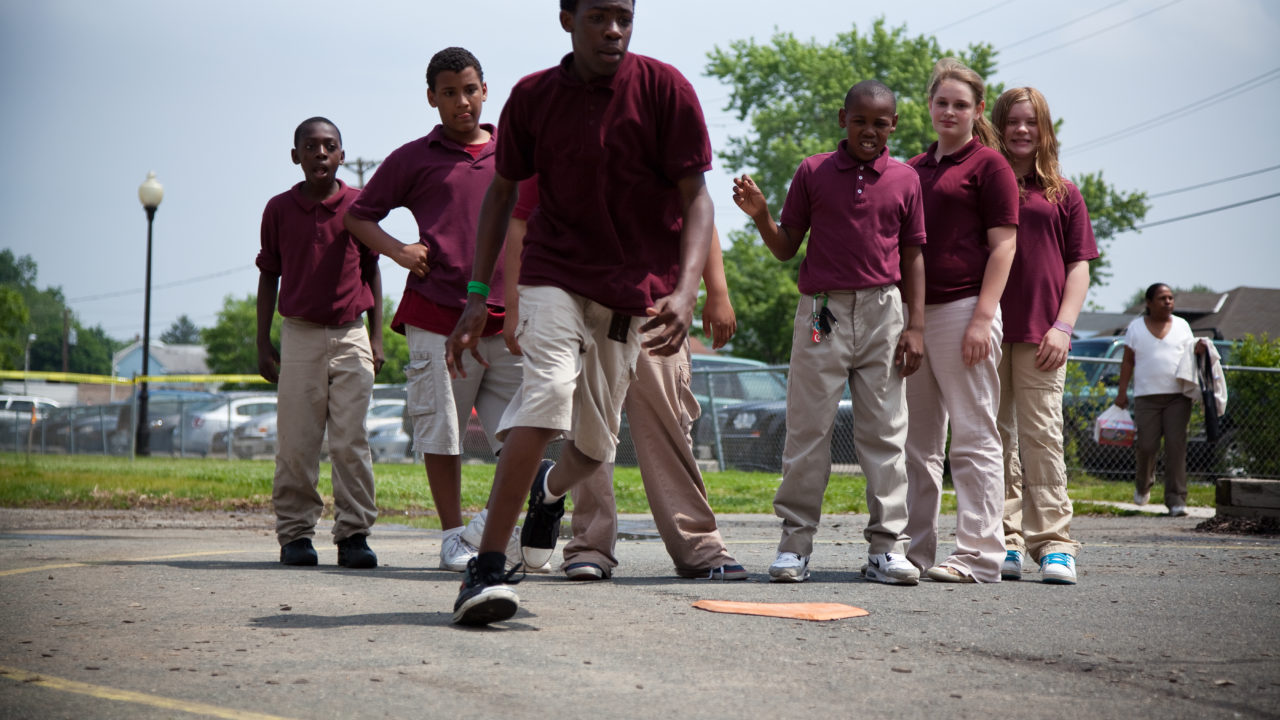Kickball

Large Group (10 and up)
Ages 6-10
Bases
10 minutes or more
Development Goal
To develop teamwork, depth-perception, and eye-hand and eye-foot coordination.
Before You Start
- Similar to baseball, kickball is played with one ball two teams and four bases.
- Begin by explaining (or reviewing) the four bases–home plate, first base, second base and third base. Demonstrate how a kicker kicks the ball from behind home plate then runs to first, second, third then back home.
- Explain the rules of the game and ask players to repeat them back to you.
- Form two equal teams.
- The team who wins Rock Paper Scissors may choose whether to kick or field first.
- The kicking team lines up and forms ‘kicking order’. This will be the order players kick for the remainder of the game.
- The fielding team goes to their positions–spread out on the field, typically with a player next to each base, a pitcher (which can also be the leader), a catcher behind home plate and players in the outfield.
Set Up
A regulation kickball field is 60′ x 60′ between the bases.
How to Play
- Play begins with the pitcher rolling the ball smoothly to home plate. The kicker must kick from behind home.
- If the ball is kicked and rolls out of bounds before going past first or third base, it is called a foul and the kicker must try again.
- Kickers must run the bases in order and may stop at any base and wait to run again at the next kick. There, however, must be only one runner on a base and they must remain in order. No runner can pass the person in front of them.
- A run is scored for the kicking team when a base-runner touches all 4 bases, in order, without being called out at any time.
- A runner advances one base on an overthrow to the base player.
- Teams switch sides after three outs or nine runs are scored. Outs are granted when:
- The pitcher controls the play of the game. Play begins with the pitcher rolling the ball to the person up to bat, the kicker. Play stops when the ball is thrown to the pitcher.
- The kicker kicks a fly ball and it is caught before it touches the ground. Note: When a fly ball is in the air, the base runners must remain on base until after the ball is caught (called tag-up) before they can advance to the next base.
- The base player has control over the ball and a foot on the base before the base-runner reaches the base.
- The base-runner is tagged on his/her body by a fielder with the ball before s/he arrives at the base. Note: If the base-runner must advance because of another runner or kicker behind, it is called a force-out and the fielding team only has to tag the base to call an out. If there is no runner or kicker behind, it is not a force-out and the fielder with the ball must tag the base-runner.
- One base-runner passes another.
- A base-runner intentionally interferes with a fielder who is trying to recover the ball.
- Three fouls by an individual kicker equal an out.
- If a ball is touched by a member of the fielding team before it bounces, it is a fair ball.
- For safety, there is no sliding or throwing of the ball at a player.
- At the end of the game, have each team do a cheer for the other team, and have teams form lines to high five each other!
Variations
See Kindergarten Kickball, Over-Under Kickball, Ultimate Kickball, Crazy Kickball, Multi-Ball, and Mountain Ball.
- With older players, you could instate a rule that allows players to throw the ball at a runner below the waist (or shoulders) in order to get that player out. A throw that hits the head results in an extra base for that runner—they go to the base they were running to and an additional base.
- Consider a no-bunting rule to make the game more fair with a variety of player skill levels.